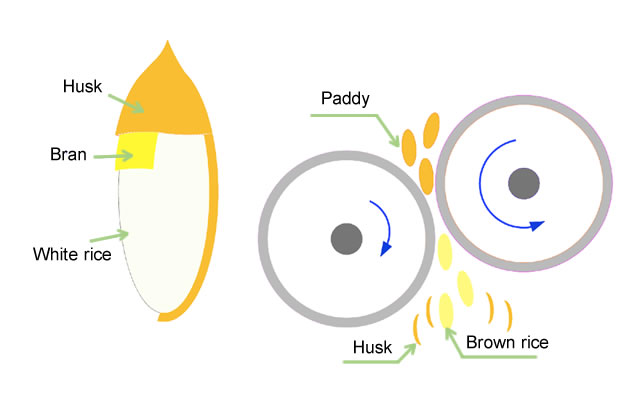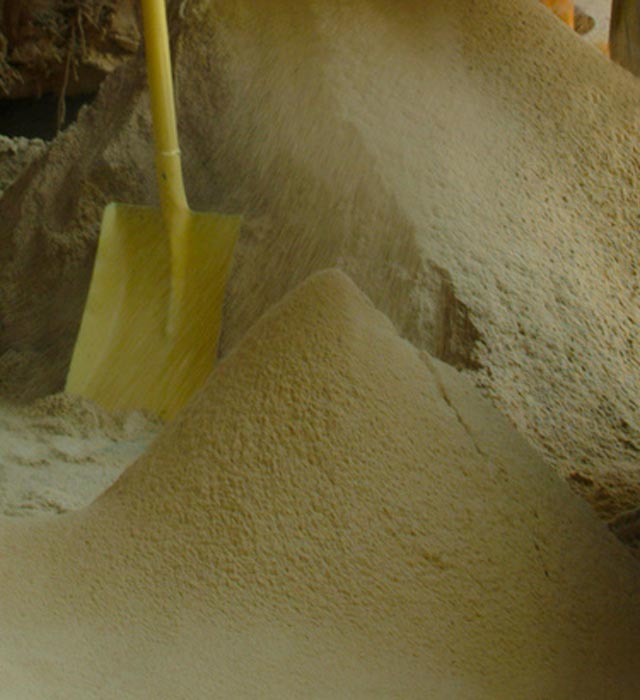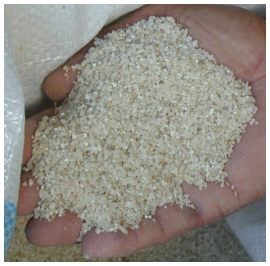Milling by-products
The main by-products of rice are rice husk or hull, rice bran, and brewer’s rice.
- Rice husks or hullsare generated during the first stage of rice milling, when rough rice or paddy rice is husked.
- Rice bran is generated when brown rice moves through the whiteners and polishers. When paddy is hand-pounded or milled in a one-pass Engleberg steel huller, rice bran is not produced separately but mixed with rice hulls.
- Brewer’s rice is separated produced when milled rice is sifted.
Rice husk

Fig. 1. Paddy grain (left) and its products after husking.
What is rice husk and what are its major products?
The rice husk, also called rice hull, is the coating on a seed or grain of rice. It is formed from hard materials, including silica and lignin, to protect the seed during the growing season. Each kg of milled white rice results in roughly 0.28 kg of rice husk as a by-product of rice production during milling.
Common products from rice husk are: solid fuel (i.e., loose form, briquettes, and pellets), carbonized rice husk produced after burning, and the remaining rice husk ash after combustion.
Rice bran
 One hundred kilogram (100 kg) of paddy rice will generate approximately 5−10 kg of bran. Rice bran is a mixture of substances, including protein, fat, ash, and crude fiber. In many cases, bran contains tiny fractions of rice hull, which increases the ash content of bran. Bran composition is largely dependent on the milling process.
One hundred kilogram (100 kg) of paddy rice will generate approximately 5−10 kg of bran. Rice bran is a mixture of substances, including protein, fat, ash, and crude fiber. In many cases, bran contains tiny fractions of rice hull, which increases the ash content of bran. Bran composition is largely dependent on the milling process.
In modern rice mills, several different kinds of bran are produced: coarse bran (from the first whitening step), fine bran (from second whitening step) and polish (from the polishing step). Polish consists of part of the endosperm and is often referred to as meal.
Rice bran has a high nutritive value. Besides proteins, rice bran is an excellent source of vitamins B and E. Bran also contains small amounts of anti-oxydants, which are considered to low cholesterol in humans. Rice bran contains 10−23% bran oil. The oily nature makes bran an excellent binder for animal feeds. Bran oil, once stabilized and extracted, is a high quality vegetable oil for cooking or eating. The conventional use of rice bran is as ingredient for animal feeds, in particular ruminants and poultry. In recent years however, advances in stabilization techniques have been made which has led to new uses for bran and its derivatives, most notably bran oil for cooking and waxes for cosmetic products. In the developing countries, rice bran is underutilized due to a lack of suitable stabilization techniques.
Brewer's rice
 Brewer’s rice is often used as ingredient for beer brewing, hence the name. In rural areas, brewer’s rice has a variety of uses including ingredient for rice flour and rice noodles.
Brewer’s rice is often used as ingredient for beer brewing, hence the name. In rural areas, brewer’s rice has a variety of uses including ingredient for rice flour and rice noodles.